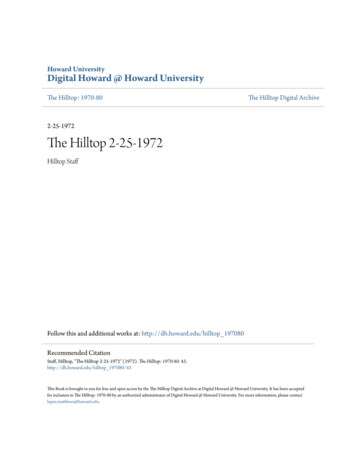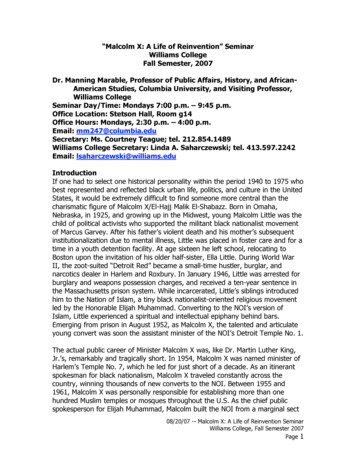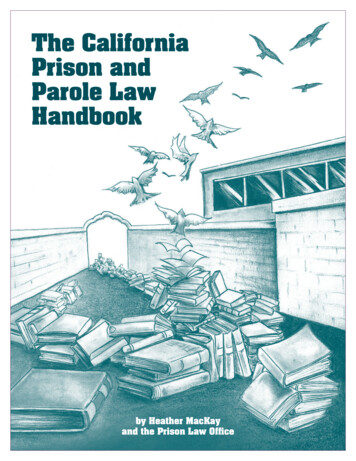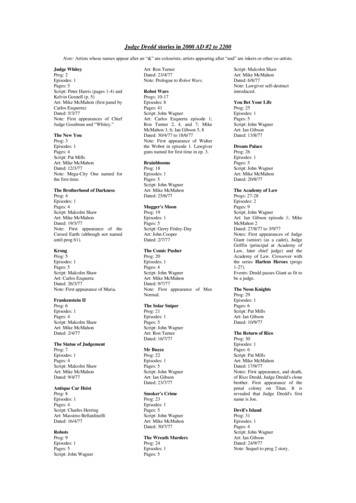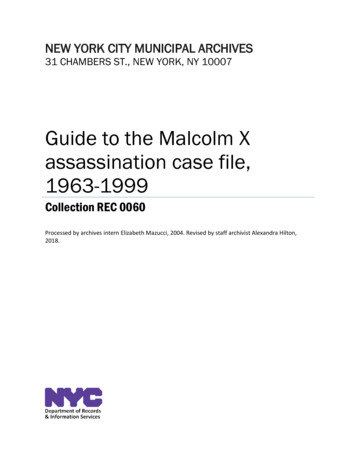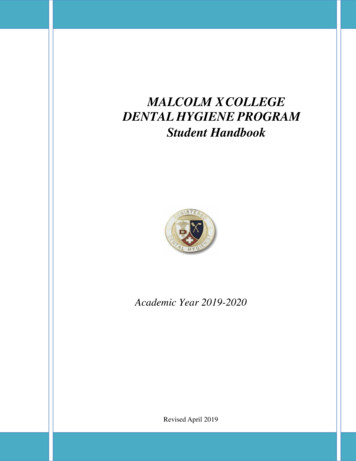
Transcription
MALCOLM X, THE PRISON YEARS:THE RELENTLESS PURSUITOF FORMAL EDUCATIONJed B. TuckerThere are many good reasons why Malcolm X’s legacy has outlived his shortlife. Though his life as a public figure lasted just thirteen years before an untimely death—murdered by gunfire at 39 years old while speaking at the AudubonBallroom—his ideas about achieving racial justice remain among the most influential of any thinker or leader before or since. He is arguably responsible for giving birth to the movements for black pride and Black Power. Perhaps even morememorable than the challenging and powerful ideas he advanced, it wasMalcolm’s literary style in the fight against racism—both in speech and writing—that make him an entirely unique figure among contemporary or subsequent civilrights leaders. This is why Ossie Davis presciently predicted over fifty years agothat despite the many enemies his fiery and controversial rhetoric produced,Malcolm X would be remembered as a martyr for the cause of racial justice.1So, it’s not surprising that his story has been told and retold countless timesthrough popular and scholarly literary works, films, theater, opera, music, ancillary products, and more.2 As it stands, Malcolm’s life is generally remembered asthe heroic struggle of an individual who overcame extreme odds all on his own,rising from ignorance and obscurity to become one of the great thinkers and leaders of his time. But it is curious that a key period in his life—the prison years—remains largely unexamined. And examining this period complicates what wethink we know about who he was and how he came to occupy such a central andinfluential space in the American psyche.One of the most important questions and the stuff of myth is how MalcolmLittle, an ordinary young man, became Malcolm X. In sermons, lectures, and public debates, Malcolm often referred to his life’s dramatic lows and highs as anexample of the kind of transformative journey he considered necessary for allAfrican Americans. He described himself as a reformed street hustler who didserious time and emerged from prison a new man, thanks largely to having discovered the teachings of the Nation of Islam’s leader, Elijah Muhammad. The prisonyears, then, are a critical period for understanding the making of Malcolm X.Jed B. Tucker is Director of Reentry and Research Scholar in the Bard Prison Initiative, Bard College,Annandale-on-Hudson, NY.184
Malcolm X, the Prison Years: The Relentless Pursuit of Formal Education185That Malcolm was incarcerated as a young man is widely known. He spent sixand a half years in three Massachusetts state prisons, from 26 February 1946 to 7August 1952.Malcolm Little mug shot. Prison file of Malcolm Little,Massachusetts Department of CorrectionsIn The Autobiography of Malcolm X as told to Alex Haley, he depicts these yearsas the most decisive of his life. It is, after all, while incarcerated that Malcolmreplaced his last name “Little” with “X,” indicating his conversion to the Nationof Islam. Yet, despite the importance of these years, numerous biographies revealalmost nothing not found in the Autobiography. There is little mention ofMalcolm’s daily life in prison, about the critical differences among the three prisons where he was held, and, most importantly, about how Malcolm navigated theMassachusetts prison system driven by a purpose to access the formal educationthat helped shape him. A fuller examination of his time inside reveals a great dealthat is left out of the popular story and missing in the existing biographical record;it offers a revealing window into Malcolm’s personal and professional capacities,aspirations, and development during these formative years.Two critical features of Malcolm’s life in prison will be challenged in thisessay. The first is his characterization of himself as a “hoodlum, thief, dope peddler, and pimp” when he entered prison.3 Indeed, it was due to his own intellectual abilities and ambition—evidenced early in his sentence—that he was able totake advantage of unusual educational resources while in prison. TheAutobiography is the source of the widely accepted portrayal of the young, wild,and hapless Malcolm, which in many ways mischaracterizes his evolution inprison as a dramatic departure from his early life. The evidence presented here
186The Journal of African American Historysupports the few scholars who have challenged this portrayal of the youngMalcolm, and also shows for the first time the strength of his commitment to formal education.The second point highlights the extent of Malcolm’s formal education whilein prison. The folklore has it that Malcolm was an extraordinary autodidact. Butrecently released primary source materials—two archives containing his lettersfrom prison and the archive of Norfolk Penal Colony Superintendent Howard Gill,in particular—reveal the extent to which he took advantage of the uncommon academic resources that became available to him in prison, including college-levelcourses.Acknowledging evidence of Malcolm’s academic and intellectual pursuitsbefore prison and his tenacity in seeking further education inside is important. Hisiconic image figures prominently in larger questions about African American masculinity, African American boys’ rejection of school, violence by and againstyoung African American men, and much else. But before we can conjecture abouthow knowing these things about Malcolm’s life might influence larger questionsof culture and politics, we need to amplify the historical record itself.EXAMINING THE NEW EVIDENCEWith several notable exceptions, the Autobiography remains the primarysource of the accepted story of Malcolm’s time in prison. The power of its narrative has overshadowed subsequent portrayals of Malcolm’s life, even those thathave raised persuasive challenges to its details. A few scholars have pointed outsome of the Autobiography’s mischaracterizations, but none has paid seriousattention to the prison years.Louis DeCaro’s On the Side of My People, for example, uses evidence fromMalcolm’s Massachusetts prison file, including letters he penned, to demonstratethat his deep interest in education began much earlier than he and others haveclaimed.4 DeCaro’s work also notes that Malcolm’s behavior in the early years ofhis sentence was closer to that of a model prisoner than the irascible and druggedout Malcolm Little portrayed in the Autobiography.Najee E. Muhammad benefitted from the subsequent appearance of threemore letters from prison, compiled in an archive in 1999, for his rich analysis ofMalcolm’s grammar school and junior high education. One of these, a letter written just nine months into Malcolm’s sentence, completely undermines his claim ofilliteracy when he entered prison.5 This letter is not only well written, but it alsodescribes his undertaking extensive writing projects during his earliest months inprison.
Malcolm X, the Prison Years: The Relentless Pursuit of Formal Education187Letter from Malcolm Little to Ella Collins, 14 Dec 1946. From the Charles H. WrightMuseum of African American History (Malcolm X Papers, MSS117)Muhammad also had DeCaro’s text to draw upon, and he references anexcerpt from Malcolm’s 27 July 1947 letter—just twenty-one months into his sen-
188The Journal of African American Historytence—in which Malcolm pleads to be transferred to the only facility in the statesystem with an academic educational program. “I was terribly upset when the warden told me I wasn’t to be transferred,” Malcolm wrote. “My sole purpose forwanting to go to Norfolk was the educational facilities. . . .” Muhammad uses thisletter, with other evidence, to build a convincing case that Malcolm’s successfulschool experience prior to incarceration, and his parents’ enduring commitment tothe education of all their children, ensured a well-developed intellectualism inMalcolm well before he went to prison.6These findings, along with several blatant chronological errors in theAutobiography, require a revisiting of Malcolm’s prison years. So why has this nothappened? In fairness to DeCaro and Muhammad, the prison years were not thefocus of their work, and neither had enough supporting material at the time, evenif it had been. But I believe even more important than alternative scholarly interests or the absence of evidentiary support, it is the broad appeal of the dominantnarrative of Malcolm’s life across the political spectrum, to which he contributed,that best explains the neglect of Malcolm’s prison years.In December 2002, new primary source material appeared for the first time,making this re-examination almost inevitable. The collection contains, inter alia,fifteen original letters from prison never revealed to the public, nor referenced inany published work.7 Read in conjunction with the Autobiography, other biographies, and Malcolm’s prison and FBI files, these letters beg for a radical rethinking of the emergence of Malcolm X. His own letters contradict his claim of beingbarely literate. And they show that Malcolm was determined from the onset of hissentence to better himself through formal education. The new story revealed bythese letters suggests new ways of interpreting other evidence of Malcolm’s intellectual development, such as his old friend and co-defendant Malcolm Jarvis’scomments about how the two men studied together extensively in prison, and howthey valued education as a form of political resistance.The untold story of how Malcolm pursued education in prison is also the storyof how tens of thousands of prisoners have managed to access higher educationfor the first time in their lives, and to realize their latent intellectual talents by taking advantage of woefully rare opportunities for self-improvement in Americanprisons. It is the story of how so many Americans throughout the nation’s historyhave returned to society successfully after years of incarceration to live productive, sustaining, and even extraordinary lives.There are at least nine published biographies of Malcolm’s life.8 The mostrecent of these, Manning Marable’s 2011 Malcolm X: A Life of Reinvention,deserves particular attention because it is the only one published since the appearance of the new prison letters. Marable realized the Autobiography’s shortcomingsat the beginning of his research in 2005. “Nearly everyone writing about Malcolm
Malcolm X, the Prison Years: The Relentless Pursuit of Formal Education189X . . . accepted as fact most, if not all, of the chronology of events and personalexperiences” in the Autobiography.9 Marable would not make this mistake; perhaps he even went too far. His work has been criticized for substantiating detailsof Malcolm’s life from what some consider suspect sources, though Marable’swork undoubtedly corrects the historical record on many fronts.10 Nonetheless, hedevotes just thirty pages of his 594-page work to the prison years, which repeatsthe narrative themes of the Autobiography.11Marable challenges what he calls the “inherent bias” of memoirs.12 Others, ina similar vein, have gone even further, suggesting that the Autobiography is largely a work of propaganda for the Nation of Islam.13 There is not much evidence tosupport these criticisms. Like all successful memoirs, it has a good story to tell, butnothing suggests it was purposefully misleading. And if it was principally a propaganda tool, it would have involved a committee of writers, yet no one has seriously argued that anyone but Malcolm and Haley collaborated on the book. As such,the Autobiography is one of various sources I use to reconstruct Malcolm’s prisonyears, and while I question a number of its biographical details, I rely heavily onpassages where Malcolm describes his feelings about his prison experiences that Ican verify through other sources. These personal, value-laden comments help usunderstand who he was and why he chose to conduct himself as he did in prison.I turn to a number of sources to suggest a new perspective on his life in prison:the totality of the letters Malcolm wrote from prison that have been made publicthrough the two recent archives; Malcolm’s 147-page Massachusetts State Prisonfile; Norfolk Superintendent Howard Gill’s personal papers (released inSeptember 2013); and Malcolm’s FBI file, that corroborates a few key details thatundermine his tale of prolonged rebelliousness during the early prison years, astory that has been adopted almost verbatim in every major account of his life.Although this new evidence challenges how we remember Malcolm, it does notpresume to settle who he “really” was or what he “really” believed. This essaypresents a close account of Malcolm’s years in prison (1946 to 1952); it does notfollow him into his years as a public figure or speculate about who he might havebecome had he not been assassinated. I share Michael E. Dyson’s critique of thetendency in so much contemporary scholarship based on weak claims thatMalcolm was a closely aligned political “brother.”14 Consider Malcolm’s wonderfully self-deprecating comment just days before his death, in which he expresseshis own doubts about his politics: “I’m man enough to tell you that I can’t put myfinger on exactly what my philosophy is now,” he declared, “but I’m flexible.”15And those who seek to dismiss or silence all that Malcolm had to say and stoodfor, because of some of his early, fiery rhetoric, should recall what he told photojournalist Gordon Parks in an interview around the same time. “I did many thingsas a [Black] Muslim that I’m sorry for now,” Malcolm admitted. “That was a bad
190The Journal of African American Historyscene, brother. The sickness and madness of those days—I’m glad to be free ofthem.”16THE MYTHS ABOUT MALCOLM’S PRISON YEARSMalcolm was 20 years old in 1946 when he was ordered to begin his sentenceat Massachusetts’s only maximum-security prison, the notorious Charlestownprison, also known as Massachusetts State Prison.17 It was a tough place for a firsttime offender, especially for a charge that could have easily carried a far shortersentence. His eight-to-ten year sentence was unusually punitive given that his oneprior arrest at age 19 was for surreptitiously pawning a relative’s fur coat (for fivedollars).18 The criminal justice system had apparently considered that first offenseso minor that despite his failing to report to his probation officer for the entire oneyear term of probation, the case was simply closed.Charlestown Prison was particularly harsh. Built in 1805, it was an aged,unkempt facility, so bad that the state closed it in 1870, only to reopen it in 1884due to overcrowding at other facilities.19 According to the 1920 annual report bythe state’s Commissioner of Corrections, Sanford Bates, Charlestown had no communal dining area; prisoners would eat alone in their cells, which, in turn, weremade unsanitary by the absence of plumbing. They relieved themselves in smallwooden buckets (the “bucket system”) that remained in their cells along with theirfood scraps until the next round of cleaning.20 Prisons like Charlestown are knownto elicit poor behavior, and Malcolm’s description in the Autobiography of how hereacted to the place suggests he played his part.When I try to separate that first year-plus that I spent at Charlestown, it runs all together in amemory of nutmeg and the other semi-drugs, of cursing guards, throwing things out of my cell,balking in the lines, dropping my tray in the dining hall, refusing to answer my number—claiming I forgot it—things like that.21In this excerpt—so frequently referenced in writing about Malcolm—we seethe self-described “bad Malcolm,” undisciplined and unruly. This image of theyoung Malcolm, both before and during his early years in prison sets the stage forthe Autobiography’s narrative of his dramatic transformation. When his older halfsister Ella Collins, whom he respected dearly, sent him money in prison to helpwith his basic needs, he claims he wasted it on drugs. He was getting high so often,he said, and acting out so much, that during his first year in prison, “I tested thelegal limit on how much time one could be kept in solitary.”22 He says he wascalled “Satan”—a chapter title in the Autobiography—because his language wasso foul.
Malcolm X, the Prison Years: The Relentless Pursuit of Formal Education191The Autobiography’s rendition of Malcolm’s lengthy sentence is just one ofthe narrative’s many inconsistencies. On the one hand, it is cited as evidence ofthe institutionalized racism of the legal system. On the other hand, by playing upMalcolm’s formidable, illicit lifestyle as a street hustler and his outrageous misbehavior in prison to establish his bad character, the unfairness of his sentence seemsto be minimized.A first point of departure from this script is knowing that Malcolm’s riskylifestyle at the time of his arrest was really an aberrant five-year period in his lateadolescence (from 1940 to early 1946), following the abrupt dissolution of hisfamily. Though his father had died violently when Malcolm was just six (on 28September 1931), his mother kept the family together for almost another eightyears, until he turned 13, at which point Malcolm and his six siblings were separated and sent to foster care following Louise Little’s commitment to a mentalinstitution in Kalamazoo, Michigan in January 1939.23 Certainly until his father’sdeath, by all accounts, the Little family was disciplined and structured, and whilethey encountered many real challenges associated with the overt racism of 1930sAmerica, Malcolm did quite well in grade school and was liked. Louise, who wasalways the family’s education advocate, managed to keep Malcolm engaged inschool years after his father was gone, such that he was voted class president inhis predominantly white school in the seventh grade in 1937.24 He spent just underone year in foster care, starting in August 1939, before visiting his stepsister EllaCollins in Boston in 1940, and then moving in with her the next year, when he was15.25 Living with Ella in Boston was Malcolm’s first experience of big-city streetlife—going out to nightclubs, getting drunk and high at late-night parties, andengaging in a variety of petty, illicit activities to support his lifestyle, which nolonger included school. The move to Boston occurred four years before he committed the burglary that resulted in his incarceration.26A second, even more damning challenge to the Autobiography’s version ofMalcolm’s prison years is that even though the behaviors he describes may be typical in prisons like Charlestown, official documents make clear he did not partakein them. Most prisons maintain detailed files that describe an individual’s activities throughout his or her incarceration. These files include prisoner work assignments, therapeutic programs and, of course, “incident reports.” Prison officialsrefer to these periodically to review treatment plans, assess progress, and provideevidence of rehabilitation for consideration by parole commissioners. These fileshave unfortunate shortcomings for understanding an individual’s prison experience. For example, while minor infractions typically garner pages of text, surprisingly little space is devoted to the instructors’ evaluations of an inmate’s skills,attitude, or accomplishments. Yet Malcolm’s prison file, as well as his July 1947letter to prison officials, which was saved in his file and referenced in at least three
192The Journal of African American Historytreatments of his life, and another December 1946 letter to his family, appearingfor the first time in the 1999 archive, make one thing irrefutably clear: Malcolmwas a model of composure throughout his six years inside.27 Yes, he performed hiswork assignments slowly at times, intentionally, to effect a change in his workassignment; and after his religious conversion he refused practices that conflictedwith Islam, but he was punished only once (and very lightly). He never engagedin combative, violent, or disruptive behavior and was certainly never sent to solitary, as he had claimed. Indeed, he received no more than a minor admonition during his entire six years behind bars. There is more. It is not only that he displayedextreme self-control and equanimity, a prison record as clean as Malcolm’s suggests someone with aspirations too important to risk. That he was locked up atsuch a young age makes the maturity of his character, as reflected in his behavior,all the more impressive and noteworthy.With this understanding of prison life, even Malcolm’s single infraction duringhis first year requires a reimagining of him as a young man. At Charlestown he wasadmonished for the minor offense of “shirking,” for which he was “placed in detention three days and work changed.”28 Based on his 14 December 1946 letter toElla—one of the three letters seen for the first time in the 1999 archive—this infraction is more likely an example of calculated resistance. The punishment got himwhat he wanted, a switch of work assignment to something more favorable. Onemonth after he was moved to the foundry, he wrote to Ella, “The work is a little harder and very much dirtier, but I don’t have any of those prejudiced, narrow-mindedinstructors messing with me now.”29 Moreover, during that first year—perhaps within the first six months—Malcolm requested to be interviewed by the recruiting delegation from the Norfolk Penal Colony, explicitly because of its well-known educational resources.30 He had expressed the same intent in an early letter to Ella, pleading, “Are you still going to get me transferred to Norfolk?”31When he was not selected for Norfolk during that first interview, Malcolmwrote to the state’s commissioner of prisons to request a second interview, pointing to his clean institutional record to bolster his case. “I’ve been confined foreighteen months now and my record is clean.”32 This time his appeal was grantedand he was moved out of Charlestown. However, because he was not moved toNorfolk, but rather to the Concord Reformatory, a prison without a school,Malcolm remained unrelenting in his transfer requests. In a letter dated 28 July1947, he reminds Commissioner Dwyer that he had been led to believe that if hewas well behaved, his request to be transferred to Norfolk would be granted. Ittook one more request before he finally succeeded. On Thursday, 25 March 1948,Malcolm was interviewed by the Norfolk board and granted the transfer.33 Suchdetermined pursuit of education from the earliest days of his incarceration is notcharacteristic of the Autobiography’s hapless and undirected young Malcolm.
Malcolm X, the Prison Years: The Relentless Pursuit of Formal Education193Malcolm Little letter to Mr. Dwyer, 28 July 1947. Prison file of Malcolm Little,Massachusetts Department of Corrections, p. 43In fact, the Autobiography contains none of this information. Nor doesMalcolm revise it later in his life. Neither he nor Haley ever mentions his requestsand appeals for the Norfolk transfer. Rather, he implies that his arrival at Norfolkwas simply good fortune. There is just one, misleading reference in theAutobiography to this episode. In a passage describing his surprise that his brothers and sisters had converted to Islam, he says, “Independently of all this, my sister Ella had been steadily working to get me transferred to the Norfolk PrisonColony.” “Somehow,” he continues, “Ella’s efforts on my behalf were successfulin late 1948.”34 He does not mention in the Autobiography how he had imploredElla in his letters repeatedly to intervene on his behalf: “Are you still going to getme transferred to Norfolk? . . . If you get me transferred to Norfolk, I’ll try andcomplete that whole book next year. . . . I only hope you don’t stop trying to getme transferred to Norfolk.”35
194The Journal of African American HistoryBeyond knowing how Malcolm actually spent his time in prison, understanding what was driving his relentless quest for formal education tells us somethingabout what education meant to him. The record reviewed thus far describes howMalcolm resisted temptations to misbehave in prison because he believed thiswould earn him access to higher education. The explanation of his old friend andco-defendant Malcolm Jarvis, that the two young men saw educating themselvesas a form of resistance to their incarceration, as so many incarcerated people do,is especially striking in light of the power of his rhetoric. Even at the moment oftheir sentencing, as Jarvis recalled:Malcolm and I couldn’t believe that society had put us away the way they had, and we werejust two people out to rebel against it. In our own way. Now the only way we knew how to rebelwas to cram some knowledge into our brains, so when we went back to society we wouldn’thave to worry about ever going back to prison—because we’d know too much and be too smartfor that (emphasis added).36NORFOLK PENAL COLONY:AN EXPERIMENT IN PROGRESSIVE INCARCERATIONMalcolm was interested in being sent to the Norfolk Penal Colony because ofits unusual educational opportunities. This was the talk among prisoners. What hecould not have known was the full extent of the radical challenge to historicalnotions of corrections promoted by Norfolk Superintendent Howard Gill, whosecommitment to education grew out of his own extensive education. A graduate ofHarvard, where he majored in sociology, and Harvard Business School, Gill’s onlyprevious encounter with prisons was a 1931 survey for the Department ofJustice.37 He was a true reformist outsider.Norfolk of the 1940s and 1950s was among a small number of prisons in U.S.history that provided a genuine alternative to punitive corrections. Its distinctioncould be considered ideological on several fronts. Opened in June 1927, it was theembodiment of early 20th-century Enlightenment thinking about human development, inasmuch as any prison could stake such a claim. Norfolk’s architects,Superintendent Howard Gill among them, believed their blueprints would revolutionize the outcomes of confinement and overcome what had become the accepted failure of prisons to rehabilitate. “To attempt to apply these techniques in aprison of the Pennsylvania or Auburn type,” declared Gill, “would be like askinga modern surgeon to operate on the kitchen table.”38While prisoners had to be selected for Norfolk from other facilities, this didnot necessarily mean, in contrast to Malcolm’s understanding, that only the bestbehaved would be admitted. Again, what made the Norfolk experiment uniquewas the belief that a well-designed prison program could literally change people.
Malcolm X, the Prison Years: The Relentless Pursuit of Formal Education195Its staff evaluations of prospective recruits from Charlestown, for example, exhibit an almost zealot-like adherence to the Norfolk approach. They would accept themost recalcitrant men from the maximum-security prisons because they believedNorfolk’s regime to be infallible.39Gill’s challenge included doing away with the usual defining practices of prisons at that time such as isolation, prisoner uniforms, and even metal bars, which hewas convinced were responsible for the institutions’ historical failures. In a pamphletintroducing Norfolk to the state legislators, he highlighted the regimen’s distinctions.They are sleeping in ordinary houses behind unlocked doors with no bars on the windows.There is not a gun in the place. At the beginning, failure was widely predicted, but thus far theexperiment has proven a striking success.40To appreciate Norfolk at that time, one has to imagine a kind of institution thatdoes not currently exist in the United States, something between the university andtoday’s conventional lockdown prison.In that brief era of progressive U.S. corrections, there were others who supported Gill’s ideological claims. The preeminent American criminologist CresseySutherland heralded the Norfolk Penal Colony as the nation’s first communityprison; staff and prisoners called it the honor camp. This was not lost on Malcolm.He refers to Norfolk admiringly in the Autobiography. What struck him mostclearly was its intellectual culture.The Colony was, comparatively, a heaven in many respects. . . . [It] represented the mostenlightened form of prison that I have ever heard of. . . . A high percentage of the Norfolk PrisonColony inmates went in for “intellectual” things, group discussions, debates, and such.41Gill encouraged this culture by brokering institutional ties to theMassachusetts Department of Education to supplement the higher educationopportunities Norfolk could not provide on its own. In its inaugural year, Norfolkmade it possible for its eighty-nine student-prisoners to enroll in university-levelcorrespondence courses.42 The following exchange between a Norfolk instructorand his supervisor about a particular student provides a telling glimpse intoNorfolk’s academic culture in the early 1930s.Question:Is he taking Engineering Thermo-Dynamics, and with what purpose?Reply:He says the mathematical part of the course is too much for him.43Gill’s commitment to his educational ideals is reflected in how he reallocatedthe prison’s budget. Whereas most prison administrators invest large sums in secu-
196The Journal of African American Historyrity infrastructure and very little in the physical resources necessary to supportinnovative programs, this calculus was reversed at Norfolk. In a 1931 report to theCommissioner of Corrections, Gill described how he addressed the inadequateschool facilities at Norfolk. “This condition was somewhat relieved by the purchase of three discarded school buildings, each 25' x 35', with some miscellaneousequipment from the Boston School Department,” he noted. “These provided alibrary and school office.”44 In most prisons today, “schools”—where they exist—are little more than a handful of unmarked rooms designated for
Malcolm X, the Prison Years: The Relentless Pursuit of Formal Education 185 That Malcolm was incarcerated as a young man is widely known. He spent six and a half years in three Massachusetts state prisons, from 26 February 1946 to 7 August 1952. Malcolm Little mug shot. Prison file of Malcolm Little, Massachusetts Department of Corrections



